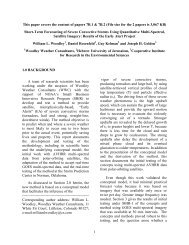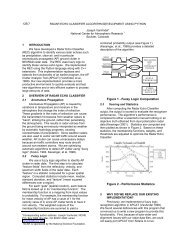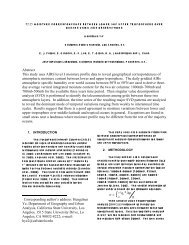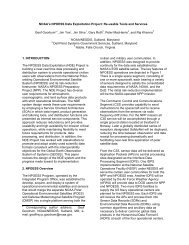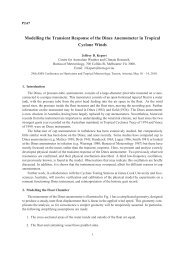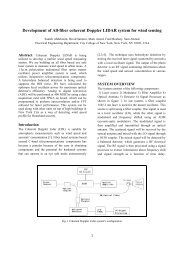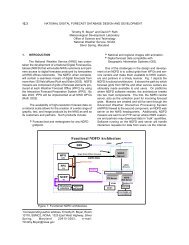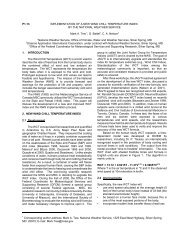Extended Abstract
Extended Abstract
Extended Abstract
Create successful ePaper yourself
Turn your PDF publications into a flip-book with our unique Google optimized e-Paper software.
8.2 SCIPUFF CAPABILITIES AND APPLICATION IN HAZARD ASSESSMENT<br />
1. INTRODUCTION<br />
R. Ian Sykes *<br />
Sage Management Enterprise, Princeton NJ<br />
SCIPUFF, Second-order Closure Integrated PUFF,<br />
is an atmospheric dispersion model using the Gaussian<br />
puff methodology to provide a three-dimensional, timedependent<br />
Lagrangian solution to the turbulent diffusion<br />
equations. Originally developed for the prediction of<br />
power plant plume impacts under the sponsorship of<br />
EPRI (Electric Power Research Institute), SCIPUFF has<br />
been extensively enhanced under DoD (Department of<br />
Defense) funding, and now describes a wide range of<br />
phenomena beyond buoyant plume rise and turbulent<br />
diffusion.<br />
2. LAGRANGIAN PUFF TECHNIQUE<br />
The time-dependent concentration field is<br />
represented as a collection of overlapping Gaussian<br />
puffs, where the Gaussian shape is described by a total<br />
mass, a centroid location, and measure of the spatial<br />
spread. The puffs are transported as Lagrangian<br />
elements, providing a grid-independent description of<br />
diffusion in inhomogeneous, time-dependent<br />
meteorology. The puff methodology can also describe<br />
multiple releases of multiple materials simultaneously.<br />
with arbitrary time-dependent and spatial<br />
characteristics.<br />
In SCIPUFF, the spatial Gaussian spread is<br />
represented in a general tensor form using the full<br />
second-moments of the concentration field, including<br />
the off-diagonal moments, so that shear distortion can<br />
be accurately described. The transport equation for the<br />
spatial moments is based on second-order turbulence<br />
closure theory, which directly relates the diffusion rates<br />
to the measurable velocity statistics. This provides a<br />
methodology that is valid over all scales, and provides a<br />
rational basis for the treatment of time averaging effects<br />
based on the assumed shape of the velocity fluctuation<br />
spectrum (Sykes and Gabruk, 1997). The closure<br />
model gives an idealized prediction that is consistent<br />
with the analytical results of Taylor (1921) for absolute<br />
dispersion, and Richardson (1926) for relative diffusion.<br />
The evolution equation for the spatial spread<br />
moments is written as<br />
dσ ∂u ∂u<br />
x′ i u′ j c′ x′ j u′ i c′<br />
= σ + σ + +<br />
dt x x Q Q<br />
ij j i<br />
ik<br />
∂ k<br />
jk<br />
∂ k<br />
where σ ij is the moment tensor, Q is the material mass<br />
in the puff, and the angle brackets indicate an integral<br />
over the puff. The first two terms represent shear<br />
distortion, and the last two are the spatial moments of<br />
*Corresponding author address: R. Ian Sykes, Sage<br />
Management, 15 Roszel Road, Suite 102, Princeton NJ<br />
08540; e-mail: ian.sykes@sage-mgt.net.<br />
the turbulent concentration flux, which is responsible for<br />
diffusion. The flux moment equations are derived from<br />
the closure model as<br />
d q<br />
x′ i u′ j c′ = Qu′ i u′ j − A x′ i u′ j c′<br />
dt<br />
Λ<br />
where<br />
= ′ ′ is the turbulent velocity scale, Λ is the<br />
2<br />
q ui ui<br />
turbulent length scale, and A is a closure constant with a<br />
value of 0.75.<br />
3. SCIPUFF MODEL CAPABILITIES<br />
The closure model provides a natural framework for<br />
predicting the concentration fluctuation variance, since<br />
this is a second-order quantity. The concentration<br />
fluctuations are driven by the turbulent velocity<br />
fluctuations and represent a statistical uncertainty in any<br />
measured concentration value. Using an assumed<br />
probability distribution shape for the fluctuations, based<br />
on the predicted mean and variance, we can provide a<br />
quantitative probability prediction for the concentration.<br />
Since the fluctuation variance is a nonlinear<br />
quantity, we need to extend the simple puff model,<br />
where each puff moves and evolves independently, by<br />
calculating the overlap contributions from puffs that are<br />
closely located. The variance is predominantly<br />
controlled by the turbulent dissipation, and modeling this<br />
term requires an evolution for an internal fluctuation<br />
length scale. Results for the fluctuation intensity<br />
compared with the laboratory experiments of Fackrell<br />
and Robins (1982) are shown in Figure 1.<br />
σ c<br />
c<br />
6<br />
4<br />
2<br />
d s = 3mm<br />
9mm<br />
15mm<br />
25mm<br />
35mm<br />
0<br />
0 2 4 6 8 10<br />
x H<br />
Fig. 1. SCIPUFF prediction of centerline fluctuation<br />
intensity in an elevated plume for different source<br />
sizes. Symbols are data from Fackrell and<br />
Robins (1982), model predictions are solid lines.<br />
The implementation of the puff overlap calculations<br />
in SCIPUFF enables other nonlinear processes to be<br />
described. Specifically, some of the major dynamics<br />
processes can be represented by providing evolution
Z (m)<br />
equations for integrated momentum and buoyancy for<br />
each puff, and assuming simple spatial shape functions<br />
for the associated velocity fields (Sykes et al. 1999).<br />
The equations for the integrated moments are based on<br />
the Navier-Stokes conservation equations, and give a<br />
reasonable representation of buoyant jets and dense<br />
gas slumping effects. Figure 2 shows an idealized<br />
calculation of two buoyant plumes in a vertical shear<br />
environment.<br />
Fig. 2. SCIPUFF prediction of buoyant plumes in a<br />
simplified wind shear.<br />
In addition to dynamics, SCIPUFF can also<br />
represent evaporating droplets and the associated<br />
thermodynamics effects. Figure 3 shows a flashing<br />
chlorine jet with initial upward momentum, but the<br />
cooling associated with the evaporation generates a<br />
cold chlorine vapor cloud which then slumps on the<br />
ground.<br />
and dense effects<br />
Fig. 3. SCIPUFF prediction of flashing chlorine jet.<br />
As a final example, SCIPUFF has also been<br />
enhanced to describe nonlinear gas phase chemical<br />
reactions. The puff overlap calculations are used to<br />
estimate the total Gaussian-weighted concentration of<br />
each chemical species for each puff. The chemical<br />
reaction mechanism is used to determine the effective<br />
change in concentrations over a timestep, and the puff<br />
species masses are adjusted in proportion to their<br />
contribution to the concentration. Figure 4 shows the<br />
SCIPUF prediction of ozone depletion and subsequent<br />
formation downwind of a NOx source, using the Carbon<br />
Bond Mechanism.<br />
4. SCIPUFF MODEL NUMERICAL FEATURES<br />
A key feature of SCIPUFF is the splitting/merging<br />
algorithms which improve the representation of<br />
inhomogeneous meteorology. The shear and diffusion<br />
terms in the moment equations are based on local<br />
z<br />
U<br />
Fig. 4. SCIPUFF prediction of ozone downwind of a NOx<br />
source, shown as the small triangle in the lower<br />
half of the plot.<br />
values of wind, wind shear and turbulence, and cannot<br />
accurately represent more complex fields. Puffs are<br />
split, conserving all the moments, when they reach a<br />
size comparable with the scale of the meteorological<br />
grid; similarly, puffs are merged when they grow large<br />
enough to overlap their neighbors sufficiently.<br />
SCIPUFF uses adaptive timesteps and adaptive<br />
spatial grids to represent concentration, dosage, and<br />
deposition fields. These techniques are well suited to<br />
Lagrangian models, where very large ranges of scales<br />
need to be represented. Near the source, puffs may<br />
have scales of a few meters or less, but the model is<br />
required to calculate effects at ranges up to 1000’s of<br />
kilometers.<br />
SCIPUFF has been evaluated using a wide range<br />
of field experiments, ranging from the short range<br />
CONFLUX experiments with downwind range of several<br />
meters up to the ANATEX and ETEX continental scale<br />
experiments.<br />
5. ROLE IN HAZARD MODELING SYSTEMS<br />
SCIPUFF is the atmospheric dispersion modeling<br />
component of two US Department of Defense hazard<br />
prediction systems. The systems are HPAC, Hazard<br />
Prediction and Assessment Capability and JEM, the<br />
Joint effects Model, HPAC is developed by the Defense<br />
Threat Reduction Agency and JEM is a DoD Program of<br />
Record under the Joint Program Executive Office for<br />
Chemical and Biological Defense (JPEO CBD). The<br />
two systems are described at:<br />
http://www.dtra.mil/rd/programs/acec/hpac.cfm, and<br />
https://jacks.jpeocbd.army.mil/jacks/Public/FactSheetPr<br />
ovider.aspx?productId=335<br />
Both of these systems comprise much more than<br />
the SCIPUFF dispersion model. They also include:
• source term models for various incidents<br />
• weapon deployments<br />
• facilities attacks or explosive events<br />
• human effects models<br />
• chemical/biological effects<br />
• nuclear radiation<br />
• global population database<br />
• casualty estimation<br />
• urban dispersion nested models<br />
• building database<br />
• meteorological data servers<br />
• forecast and observations<br />
• global terrain database<br />
These capabilities are essential for predicting<br />
hazard effects. The availability of meteorological data is<br />
crucial, and must be provided in a timely manner. Also,<br />
the prediction of human effects is an important aspect,<br />
for consequence assessment. The broad range of<br />
capabilities in SCIPUFF has been developed to provide<br />
the atmospheric dispersion calculation, linking the<br />
source term models with the human effects models. A<br />
sample output display from HPAC is shown in Figure 5.<br />
5. REFERENCES<br />
Fackrell, J.E. & A.G. Robins (1982), Concentration<br />
fluctuations and fluxes in plumes from a point source<br />
in a turbulent boundary layer, J. Fluid Mech.,117,1-26.<br />
Richardson, L. F. (1926), "Atmospheric Diffusion shown<br />
on a DistanceNeighbour Graph", Proc. Roy. Soc.<br />
Lond. A, 110, 709-737<br />
Sykes, R. I. and R. S. Gabruk (1997), "A second-order<br />
closure model for the effect of averaging time on<br />
turbulent plume dispersion", J. Appl. Met, 36, 165-184<br />
Sykes, R. I., C. P. Cerasoli and D. S. Henn (1999), "The<br />
representation of dynamic flow effects in a Lagrangian<br />
puff dispersion model", J. Haz. Mat., A:64, 223-247<br />
Taylor, G. I. (1921), "Diffusion by continuous<br />
movements", Proc. Lond. Math. Soc. (Ser. 2), 20,<br />
196-211<br />
Figure 5. Sample HPAC output display illustrating the building effects submodel, building database, and<br />
human effects output with casualty estimation



